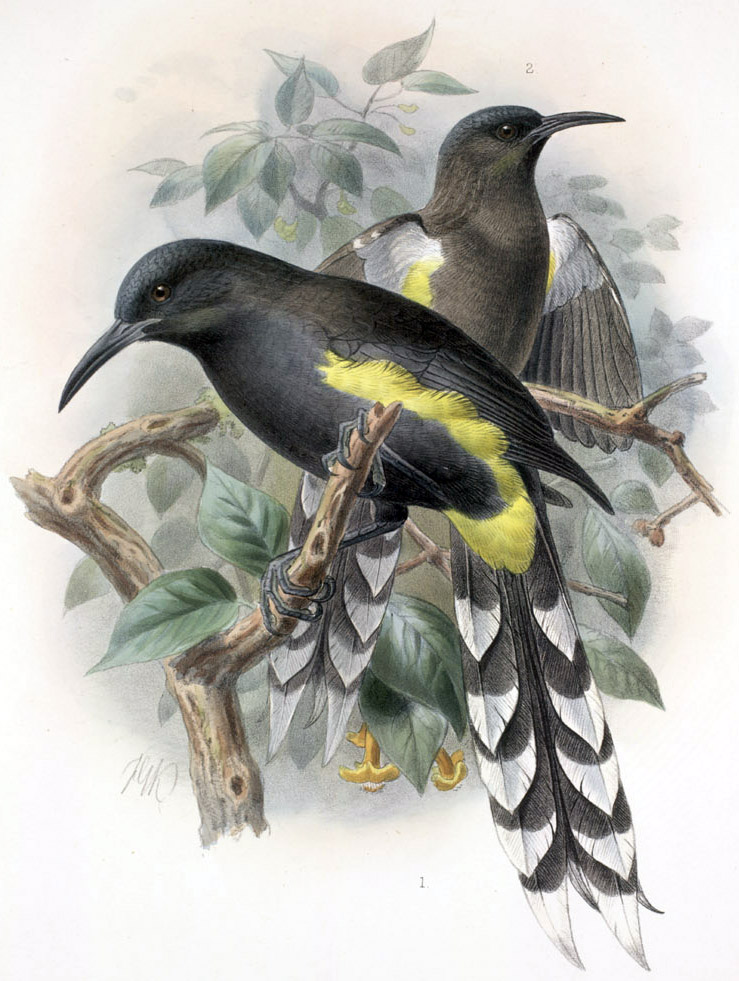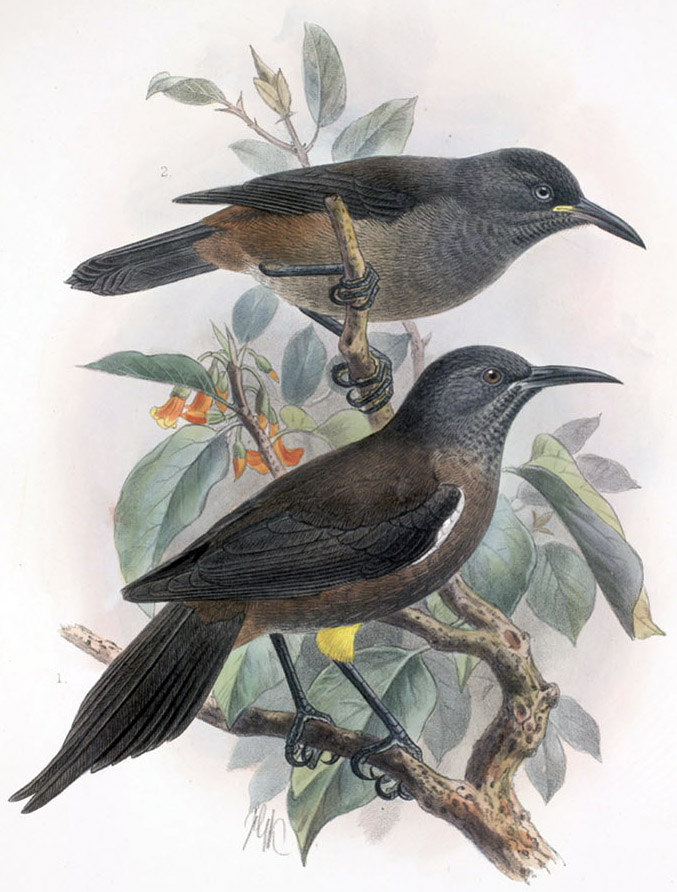|
Moho (genus)
__NOTOC__ ''Moho'' is a genus of extinct birds in the Hawaiian bird family, Mohoidae, that were endemic to the Hawaiian Islands. Members of the genus are known as ''ōō'' in the Hawaiian language. Their plumage was generally striking glossy black; some species had yellowish axillary tufts and other black outer feathers. Most of these species became extinct by habitat loss, the introduction of mammalian predators (like rats, pigs, and mongooses), and by extensive hunting (their plumage was used for the creation of precious ''aahu alii'' (robes) and ''ahu ula'' (capes) for '' alii'' (Hawaiian nobility). The Kauai ōō was the last species of this genus to become extinct, probably a victim of avian malaria. Until recently, the birds in this genus were thought to belong to the family Meliphagidae ( honeyeaters) because they looked and acted so similar to members of that family, including many morphological details. A 2008 study argued, on the basis of a phylogenetic analysis ... [...More Info...] [...Related Items...] OR: [Wikipedia] [Google] [Baidu] |
Kauaʻi ʻōʻō
The Kauaʻi ʻōʻō () or ''ʻōʻōʻāʻā'' (''Moho braccatus'') was the last member of the ʻōʻō ('' Moho'') genus within the Mohoidae family of birds from the islands of Hawaiʻi. The entire family is now extinct. It was previously regarded as a member of the Australo-Pacific honeyeaters (family Meliphagidae). The bird was endemic to the island of Kauaʻi. It was common in the subtropical forests of the island until the early twentieth century, when its decline began. It was last seen in 1985, and last heard in 1987. The causes of its extinction include the introduction of predators (such as the Polynesian rat, small Indian mongoose, and the domestic pig), mosquito-borne diseases, and habitat destruction. It was the last surviving member of the Mohoidae, which had originated over 15-20 million years prior during the Miocene, with the Kauaʻi ʻōʻō's extinction marking the only extinction of an entire avian family in modern times ("modern" meaning post-1500 AD). ... [...More Info...] [...Related Items...] OR: [Wikipedia] [Google] [Baidu] |
Honeyeater
The honeyeaters are a large and diverse family (biology), family, Meliphagidae, of small to medium-sized birds. The family includes the Epthianura, Australian chats, myzomelas, friarbirds, wattlebirds, Manorina, miners and melidectes. They are most common in Australia and New Guinea, and found also in New Zealand, the Pacific islands as far east as Samoa and Tonga, and the islands to the north and west of New Guinea known as Wallacea. Bali, on the other side of the Wallace Line, has a single species. In total there are List of honeyeaters, 186 species in 55 genus, genera, roughly half of them native to Australia, many of the remainder occupying New Guinea. With their closest relatives, the Maluridae (Australian fairy-wrens), Pardalotidae (pardalotes), and Acanthizidae (thornbills, Australian warblers, scrubwrens, etc.), they comprise the superfamily Meliphagoidea and originated early in the evolutionary history of the oscine passerine radiation. Although honeyeaters look and beh ... [...More Info...] [...Related Items...] OR: [Wikipedia] [Google] [Baidu] |
Moho Nobilis-Keulemans
Moho may refer to: Birds * ''Moho'' (genus), an extinct genus of birds in the family Mohoidae * The Hawaiian name of the Hawaiian rail, an extinct species * The Māori name of the North Island takahe, an extinct species * A local name for the oriole warbler, ''Hypergerus atriceps'' Computers * Moho (software), 2D animation software also sold as Anime Studio * Moho Engine, used in games such as '' Supreme Commander'' * ''Moho'' (video game), a 2000 Dreamcast game by Take-Two Interactive Geology and geography * Moho discontinuity, the boundary between the Earth's crust and the mantle * Moho, Puno, a city in Peru * Moho District, Peru * Moho Province, Peru * Moho River, in Guatemala and Belize Other uses * Model of Human Occupation, a model of practice in occupational therapy * Mount Holyoke College, a small, historically-women's liberal arts college in South Hadley, MA, USA *Motorhome A motorhome (or motor coach) is a type of self-propelled recreational vehicle (RV) which of ... [...More Info...] [...Related Items...] OR: [Wikipedia] [Google] [Baidu] |
Bishop's ʻōʻō
The Bishop's ‘ō‘ō or Molokai ‘ō‘ō (''Moho bishopi'') was the penultimate member of the extinct genus of the ‘ō‘ōs ('' Moho'') within the extinct family Mohoidae. It was previously regarded as member of the Australo-Pacific honeyeaters (Meliphagidae).Fleischer R.C., James H.F., and Olson S.L. (2008). Convergent Evolution of Hawaiian and Australo-Pacific Honeyeaters from Distant Songbird Ancestors. Current Biology, Volume 18, Issue 24, 1927-1931, 11 December 2008. Lionel Walter Rothschild named it after Charles Reed Bishop, the founder of the Bishop Museum. Description It was discovered in 1892 by Henry C. Palmer, a bird collector for Lord Rothschild. Its length was about 29 centimeters. The tail had reached a length of 10 centimeters. The plumage was general glossy black with yellow feather tufts on the maxillaries, beneath the wings and the undertail coverts. Their songs were simple two notes, ''took-took'', which could be heard for miles. Distribution It was ... [...More Info...] [...Related Items...] OR: [Wikipedia] [Google] [Baidu] |
Oʻahu ʻōʻō
The O‘ahu ‘ō‘ō (''Moho apicalis'') was a member of the extinct genus of the ‘ō‘ōs ('' Moho'') within the extinct family Mohoidae. It was previously regarded as member of the Australo-Pacific honeyeaters (Meliphagidae). Description The males reached a length of 30.5 centimeters. The wing length was 10.5 to 11.4 centimeters, the culmen was between 3.5 and 3.8 centimetres and the tarsus was between 3.4 and 3.8 centimeters. The females were smaller. The plumage was predominantly sooty black. The tail feathers were brown and had, with the exception of the two central tail feathers, white tips. Further characteristics were the white feather tufts under the axillaries and the two narrow central tail feathers which changed into fine hair-like or fibrous tips. The flanks and the undertail coverts were colored deeply yellow. The bill and the tarsus were black. Its biology was not well-studied. Distribution and habitat Its habitat was the mountain forests on O‘ahu. Extinc ... [...More Info...] [...Related Items...] OR: [Wikipedia] [Google] [Baidu] |
Moho Apicalis-Keulemans
Moho may refer to: Birds * ''Moho'' (genus), an extinct genus of birds in the family Mohoidae * The Hawaiian name of the Hawaiian rail, an extinct species * The Māori name of the North Island takahe, an extinct species * A local name for the oriole warbler, ''Hypergerus atriceps'' Computers * Moho (software), 2D animation software also sold as Anime Studio * Moho Engine, used in games such as '' Supreme Commander'' * ''Moho'' (video game), a 2000 Dreamcast game by Take-Two Interactive Geology and geography * Moho discontinuity, the boundary between the Earth's crust and the mantle * Moho, Puno, a city in Peru * Moho District, Peru * Moho Province, Peru * Moho River, in Guatemala and Belize Other uses * Model of Human Occupation, a model of practice in occupational therapy * Mount Holyoke College, a small, historically-women's liberal arts college in South Hadley, MA, USA *Motorhome A motorhome (or motor coach) is a type of self-propelled recreational vehicle (RV) which of ... [...More Info...] [...Related Items...] OR: [Wikipedia] [Google] [Baidu] |
John Zorn
John Zorn (born September 2, 1953) is an American composer, conductor, saxophonist, arranger and producer who "deliberately resists category". Zorn's avant-garde and experimental approaches to composition and improvisation are inclusive of jazz, rock, hardcore, classical, contemporary, surf, metal, soundtrack, ambient, and world music.Milkowski, B."John Zorn: One Future, Two Views"(interview) in ''Jazz Times'', March 2000, pp. 28–35,118–121; accessed July 24, 2010. In 2013, ''Down Beat'' described Zorn as "one of our most important composers" and in 2020 ''Rolling Stone'' noted that " ltough Zorn has operated almost entirely outside the mainstream, he's gradually asserted himself as one of the most influential musicians of our time".Steamer, H.‘He Made the World Bigger’: Inside John Zorn's Jazz-Metal Multiverse ''Rolling Stone'', June 22, 2020. Zorn entered New York City's downtown music scene in the mid-1970s, collaborating with improvising artists while developin ... [...More Info...] [...Related Items...] OR: [Wikipedia] [Google] [Baidu] |
Silky-flycatcher
The silky-flycatchers are a small family, Ptiliogonatidae, of passerine birds. The family contains only four species in three genera. They were formerly lumped with waxwings and hypocolius in the family Bombycillidae, and they are listed in that family by the Sibley-Monroe checklist. The family is named for their silky plumage and their aerial flycatching techniques, although they are unrelated to the Old World flycatchers (Muscicapidae) and the tyrant flycatchers (Tyrannidae). They occur mainly in Central America from Panama to Mexico, with one species, the phainopepla, extending northwards into the southwestern US. Most do not engage in long-distance migration (instead wandering widely in search of fruit), but the phainopepla is migratory over the northern part of its range. They are related to waxwings, and like that group have soft silky plumage, usually gray or pale yellow in color. All species, with the exception of the black-and-yellow phainoptila, have small crests. T ... [...More Info...] [...Related Items...] OR: [Wikipedia] [Google] [Baidu] |
Palmchat
The palmchat (''Dulus dominicus'') is a small, long-tailed passerine bird, the only species in the genus ''Dulus'' and the family Dulidae endemic to the Caribbean island of Hispaniola (split between the Dominican Republic and Haiti). It is related to the waxwings, family Bombycillidae. Its name reflects its strong association with palms for feeding, roosting, and nesting. The palmchat is the national bird of the Dominican Republic. Taxonomy In 1760 the French zoologist Mathurin Jacques Brisson included a description of the palmchat in his ''Ornithologie'' based on a specimen collected from the French colony of Saint-Domingue, modern Haiti. He used the French name ''Le tangara de S. Dominigue'' and the Latin ''Tangara Dominicensis''. The two stars (**) at the start of the section indicates that Brisson based his description on the examination of a specimen. Although Brisson coined Latin names, these do not conform to the binomial system and are not recognised by the Internati ... [...More Info...] [...Related Items...] OR: [Wikipedia] [Google] [Baidu] |
Waxwing
The waxwings are three species of passerine birds classified in the genus ''Bombycilla''. They are pinkish-brown and pale grey with distinctive smooth plumage in which many body feathers are not individually visible, a black and white eyestripe, a crest, a square-cut tail and pointed wings. Some of the wing feathers have red tips, the resemblance of which to sealing wax gives these birds their common name. According to most authorities, this is the only genus placed in the family Bombycillidae, although sometimes the family is extended to include related taxa that are more usually included in separate families: silky flycatchers (Ptiliogonatidae (e.g. '' Phainoptila'')), ''Hypocolius'' (Hypocoliidae), ''Hylocitrea'' (Hylocitreidae), palmchats (Dulidae) and the Hawai'ian 'honeyeaters' (Mohoidae). There are three species: the Bohemian waxwing (''B. garrulus''), the Japanese waxwing (''B. japonica'') and the cedar waxwing (''B. cedrorum''). Waxwings are not long-distance migrants, ... [...More Info...] [...Related Items...] OR: [Wikipedia] [Google] [Baidu] |




.jpg)
